 |
 |
|
 |
|
 |
|  |
|  |
|
 |
|
 |
|  |
|  |
|
 |
I was curious about how Norbert Kern's light & shadows lighting
environment compares to my 4th prefab render rig's outdoor setting, so I
wrote a couple of scenes to illustrate them.
Image nkern-light+shadows2.jpg uses Norbert's lighting setup, including
his sky, his radiosity setting, and the finish he posted. The colors
used were:
Gray sphere: srgb 0.5
Green sphere: CHSV2RGB (<115, 0.65, 0.08>) / 0.6
Post: CHSV2RGB (<23, 0.75, 0.12>) / 0.6
Yellow-green sphere: CHSV2RGB (<92, 0.8, 0.12>) / 0.6
White sphere: srgb 1
Brown square: CHSV2RGB (<23, 0.75, 0.12>) / 0.6
Green square: CHSV2RGB (<91, 0.80, 0.18>) / 0.6
I had previously derived the greens and the brown from photographs I
took of grass, leaves, and soil. I calibrated the colors against 96%
white paper, decreasing the assumed paper luminance very slightly due to
its age.
The rc3-nkern-ltshad-e*-2.jpg images used my 4th prefab render rig. The
following colors were used, with the diffuse finish values applied
directly to the objects:
Gray sphere: srgb 0.5 diffuse 0.6
Green sphere: CHSV2RGB (<115, 0.65, 0.08>) diffuse 1
Post: CHSV2RGB (<23, 0.75, 0.12>) diffuse 1
Yellow-green sphere: CHSV2RGB (<92, 0.8, 0.12>) diffuse 1
White sphere: srgb 1 diffuse 0.6
I used these radiosity settings:
radiosity
{ count 200
error_bound 0.5
normal on
Radiosity_Pretrace (0.8, 2) // posted in p.b.s-f
recursion_limit 2
}
In addition, the render rig automatically supplies radiosity { media on
}, because the sky is fog based.
The lighting is not so straightforward, since the render rig creates its
own black box environment, but since I wrote it, I can give some
specifics. The dirt and grass have these colors with diffuse 1:
Dirt: CHSV2RGB (<23, 0.75, 0.12>)
Grass: CHSV2RGB (<91, 0.80, 0.18>)
The rig uses rgb <1.038, 0.989, 0.956> for the direct sunlight. The
sky, disregarding the clouds, contributes about 1/8 the luminance of the
direct sun; this is the best amount I could determine for a Sun at 45°.
(I positioned the Sun at Norbert's 47°, but I haven't gone through the
trouble of programming dynamic sky colors into my render rig, and the 2°
shouldn't make that much difference.) I did not take aerosols into
account, and I presumed that my sources were measured at low turbidity.
And if you know me, you don't need to ask about the assumed_gamma.
The exposure figure is a multiplier for the sunlight and sky colors.
Since all renders used radiosity with POV-Ray 3.7, any ambient settings
were moot.
As you can see, my sky is considerably lighter than Norbert's, resulting
in lower contrast. However, Norbert's scene is in a heavily forested
area, which naturally lends itself to dark shadows. When I look
outside, my instinct tells me that the sky should be lighter than I have
made it, but for the time being, I am trusting scientifically measured
numbers over my non-linear vision. It should be noted that since blue
is a low luminosity color, that 1/8 figure is lower than the flux ratio.
Post a reply to this message
Attachments:
Download 'nkern-light+shadows2.jpg' (35 KB)
Download 'rc3-nkern-ltshad-e1-2.jpg' (51 KB)
Download 'rc3-nkern-ltshad-e2-2.jpg' (60 KB)
Download 'rc3-nkern-ltshad-e4-2.jpg' (69 KB)
Download 'rc3-nkern-ltshad-e8-2.jpg' (66 KB)
Preview of image 'nkern-light+shadows2.jpg'
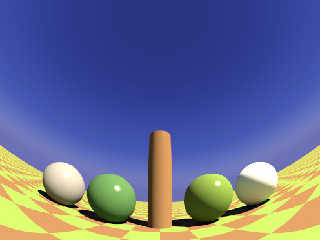
Preview of image 'rc3-nkern-ltshad-e1-2.jpg'
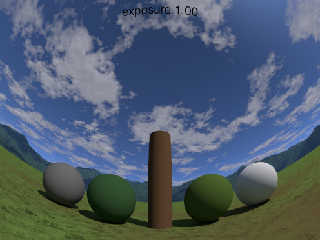
Preview of image 'rc3-nkern-ltshad-e2-2.jpg'
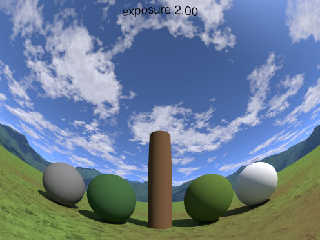
Preview of image 'rc3-nkern-ltshad-e4-2.jpg'
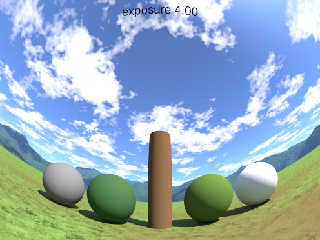
Preview of image 'rc3-nkern-ltshad-e8-2.jpg'
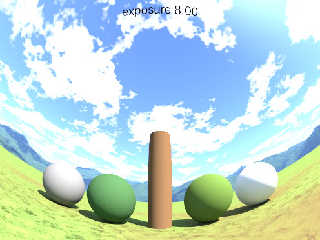
|
 |
|  |
|  |
|
 |
|
 |
|  |
|  |
|
 |
Cousin Ricky <ric### [at] yahoo com> wrote:
> I was curious about how Norbert Kern's light & shadows lighting
> environment compares to my 4th prefab render rig's outdoor setting, so I
> wrote a couple of scenes to illustrate them.
>
> Image nkern-light+shadows2.jpg uses Norbert's lighting setup, including
> his sky, his radiosity setting, and the finish he posted. The colors
> used were:
>
> Gray sphere: srgb 0.5
> Green sphere: CHSV2RGB (<115, 0.65, 0.08>) / 0.6
> Post: CHSV2RGB (<23, 0.75, 0.12>) / 0.6
> Yellow-green sphere: CHSV2RGB (<92, 0.8, 0.12>) / 0.6
> White sphere: srgb 1
> Brown square: CHSV2RGB (<23, 0.75, 0.12>) / 0.6
> Green square: CHSV2RGB (<91, 0.80, 0.18>) / 0.6
>
> I had previously derived the greens and the brown from photographs I
> took of grass, leaves, and soil. I calibrated the colors against 96%
> white paper, decreasing the assumed paper luminance very slightly due to
> its age.
>
> The rc3-nkern-ltshad-e*-2.jpg images used my 4th prefab render rig. The
> following colors were used, with the diffuse finish values applied
> directly to the objects:
>
> Gray sphere: srgb 0.5 diffuse 0.6
> Green sphere: CHSV2RGB (<115, 0.65, 0.08>) diffuse 1
> Post: CHSV2RGB (<23, 0.75, 0.12>) diffuse 1
> Yellow-green sphere: CHSV2RGB (<92, 0.8, 0.12>) diffuse 1
> White sphere: srgb 1 diffuse 0.6
>
> I used these radiosity settings:
>
> radiosity
> { count 200
> error_bound 0.5
> normal on
> Radiosity_Pretrace (0.8, 2) // posted in p.b.s-f
> recursion_limit 2
> }
>
> In addition, the render rig automatically supplies radiosity { media on
> }, because the sky is fog based.
>
> The lighting is not so straightforward, since the render rig creates its
> own black box environment, but since I wrote it, I can give some
> specifics. The dirt and grass have these colors with diffuse 1:
>
> Dirt: CHSV2RGB (<23, 0.75, 0.12>)
> Grass: CHSV2RGB (<91, 0.80, 0.18>)
>
> The rig uses rgb <1.038, 0.989, 0.956> for the direct sunlight. The
> sky, disregarding the clouds, contributes about 1/8 the luminance of the
> direct sun; this is the best amount I could determine for a Sun at 45°.
> (I positioned the Sun at Norbert's 47°, but I haven't gone through the
> trouble of programming dynamic sky colors into my render rig, and the 2°
> shouldn't make that much difference.) I did not take aerosols into
> account, and I presumed that my sources were measured at low turbidity.
> And if you know me, you don't need to ask about the assumed_gamma.
>
> The exposure figure is a multiplier for the sunlight and sky colors.
>
> Since all renders used radiosity with POV-Ray 3.7, any ambient settings
> were moot.
>
> As you can see, my sky is considerably lighter than Norbert's, resulting
> in lower contrast. However, Norbert's scene is in a heavily forested
> area, which naturally lends itself to dark shadows. When I look
> outside, my instinct tells me that the sky should be lighter than I have
> made it, but for the time being, I am trusting scientifically measured
> numbers over my non-linear vision. It should be noted that since blue
> is a low luminosity color, that 1/8 figure is lower than the flux ratio.
Hi,
I like your fourth image with exposure 4.0. It looks like a good summer sky
setting.
My settings for L&S aren't suitable for naturalistic images.
If I would start from scratch, there would be much more shadows and stronger
lights. Of course then I would increase the sky brightness values too - a bit.
Most textures were tweaked to increase the hue values. So the image is green in
general with blueish shadows. Flowers and animals introduce some colorful spots.
The impression I wanted to generate is something like a glade, with much
stronger contrasts than in reality - like in the part render from a different
perspective.
My personal standard set for sky and light is rather simple -
#declare lights = <-80000,50000,-50000>;
light_source {
lights,
color srgb <2.42,2.23,1.87>
}
sky_sphere {
pigment {
function {max (min (y, 1), 0)}
color_map {
[0 srgb <212,221,239>/255]
[0.1029 srgb <219,229,244>/255]
[0.1512 srgb <233,241,250>/255]
[0.1949 srgb <223,239,252>/255]
[0.2444 srgb <201,227,252>/255]
[0.2921 srgb <180,213,250>/255]
[0.3732 srgb <144,180,239>/255]
[0.4255 srgb <137,172,235>/255]
[0.7067 srgb <97,126,198>/255]
[0.774 srgb <92,119,190>/255]
[0.8275 srgb <88,114,185>/255]
[0.885 srgb <85,111,180>/255]
[0.9425 srgb <82,107,175>/255]
[1 srgb <79,103,170>/255]
}
}
}
I got the sky values from a photograph and the light values are very old - in
fact I derived them from radiosity newsgroups discussions back in 2000 or 2001
(rgb <1,0.87,0.57>*7 IIRC).
This differs very much from your value - I should take a look in your render
rig...
Regards,
Norbert com> wrote:
> I was curious about how Norbert Kern's light & shadows lighting
> environment compares to my 4th prefab render rig's outdoor setting, so I
> wrote a couple of scenes to illustrate them.
>
> Image nkern-light+shadows2.jpg uses Norbert's lighting setup, including
> his sky, his radiosity setting, and the finish he posted. The colors
> used were:
>
> Gray sphere: srgb 0.5
> Green sphere: CHSV2RGB (<115, 0.65, 0.08>) / 0.6
> Post: CHSV2RGB (<23, 0.75, 0.12>) / 0.6
> Yellow-green sphere: CHSV2RGB (<92, 0.8, 0.12>) / 0.6
> White sphere: srgb 1
> Brown square: CHSV2RGB (<23, 0.75, 0.12>) / 0.6
> Green square: CHSV2RGB (<91, 0.80, 0.18>) / 0.6
>
> I had previously derived the greens and the brown from photographs I
> took of grass, leaves, and soil. I calibrated the colors against 96%
> white paper, decreasing the assumed paper luminance very slightly due to
> its age.
>
> The rc3-nkern-ltshad-e*-2.jpg images used my 4th prefab render rig. The
> following colors were used, with the diffuse finish values applied
> directly to the objects:
>
> Gray sphere: srgb 0.5 diffuse 0.6
> Green sphere: CHSV2RGB (<115, 0.65, 0.08>) diffuse 1
> Post: CHSV2RGB (<23, 0.75, 0.12>) diffuse 1
> Yellow-green sphere: CHSV2RGB (<92, 0.8, 0.12>) diffuse 1
> White sphere: srgb 1 diffuse 0.6
>
> I used these radiosity settings:
>
> radiosity
> { count 200
> error_bound 0.5
> normal on
> Radiosity_Pretrace (0.8, 2) // posted in p.b.s-f
> recursion_limit 2
> }
>
> In addition, the render rig automatically supplies radiosity { media on
> }, because the sky is fog based.
>
> The lighting is not so straightforward, since the render rig creates its
> own black box environment, but since I wrote it, I can give some
> specifics. The dirt and grass have these colors with diffuse 1:
>
> Dirt: CHSV2RGB (<23, 0.75, 0.12>)
> Grass: CHSV2RGB (<91, 0.80, 0.18>)
>
> The rig uses rgb <1.038, 0.989, 0.956> for the direct sunlight. The
> sky, disregarding the clouds, contributes about 1/8 the luminance of the
> direct sun; this is the best amount I could determine for a Sun at 45°.
> (I positioned the Sun at Norbert's 47°, but I haven't gone through the
> trouble of programming dynamic sky colors into my render rig, and the 2°
> shouldn't make that much difference.) I did not take aerosols into
> account, and I presumed that my sources were measured at low turbidity.
> And if you know me, you don't need to ask about the assumed_gamma.
>
> The exposure figure is a multiplier for the sunlight and sky colors.
>
> Since all renders used radiosity with POV-Ray 3.7, any ambient settings
> were moot.
>
> As you can see, my sky is considerably lighter than Norbert's, resulting
> in lower contrast. However, Norbert's scene is in a heavily forested
> area, which naturally lends itself to dark shadows. When I look
> outside, my instinct tells me that the sky should be lighter than I have
> made it, but for the time being, I am trusting scientifically measured
> numbers over my non-linear vision. It should be noted that since blue
> is a low luminosity color, that 1/8 figure is lower than the flux ratio.
Hi,
I like your fourth image with exposure 4.0. It looks like a good summer sky
setting.
My settings for L&S aren't suitable for naturalistic images.
If I would start from scratch, there would be much more shadows and stronger
lights. Of course then I would increase the sky brightness values too - a bit.
Most textures were tweaked to increase the hue values. So the image is green in
general with blueish shadows. Flowers and animals introduce some colorful spots.
The impression I wanted to generate is something like a glade, with much
stronger contrasts than in reality - like in the part render from a different
perspective.
My personal standard set for sky and light is rather simple -
#declare lights = <-80000,50000,-50000>;
light_source {
lights,
color srgb <2.42,2.23,1.87>
}
sky_sphere {
pigment {
function {max (min (y, 1), 0)}
color_map {
[0 srgb <212,221,239>/255]
[0.1029 srgb <219,229,244>/255]
[0.1512 srgb <233,241,250>/255]
[0.1949 srgb <223,239,252>/255]
[0.2444 srgb <201,227,252>/255]
[0.2921 srgb <180,213,250>/255]
[0.3732 srgb <144,180,239>/255]
[0.4255 srgb <137,172,235>/255]
[0.7067 srgb <97,126,198>/255]
[0.774 srgb <92,119,190>/255]
[0.8275 srgb <88,114,185>/255]
[0.885 srgb <85,111,180>/255]
[0.9425 srgb <82,107,175>/255]
[1 srgb <79,103,170>/255]
}
}
}
I got the sky values from a photograph and the light values are very old - in
fact I derived them from radiosity newsgroups discussions back in 2000 or 2001
(rgb <1,0.87,0.57>*7 IIRC).
This differs very much from your value - I should take a look in your render
rig...
Regards,
Norbert
Post a reply to this message
Attachments:
Download 'l&s_part.jpg' (775 KB)
Preview of image 'l&s_part.jpg'
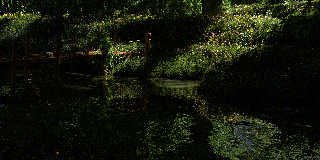
|
 |
|  |
|  |
|
 |
|
 |
|  |
|  |
|
 |
On 2020-04-30 5:16 PM (-4), Norbert Kern wrote:
>
> I got the sky values from a photograph and the light values are very old - in
> fact I derived them from radiosity newsgroups discussions back in 2000 or 2001
> (rgb <1,0.87,0.57>*7 IIRC).
The problem with photographs of the sky is that I cannot tell how bright
the sky is in relation to sunlight. The color that shows up in the
photo also depends on the camera's white point. This is why I've
searched for solar spectral and absorption data to inform my colors.
I have found photographs useful in estimating the gradient; however, one
must be careful that the photo does not exceed the RGB dynamic range.
This happens with quite a few of my outdoor photos. In such cases,
sampling is useless.
One thing that has surprised me over the years is just how dark plants
are. For example, the darker green sphere, which is somewhat lighter
(and bluer) than the _Cordia_ leaf I sampled, works out to rgb <0.032,
0.080, 0.028>, with luminance a paltry 0.066. But with sky blue turning
out as dark as it is, plants have to be even darker. I think the
wildcard here is that we simply underestimate how freaking bright the
Sun is--and this brightens up the whole landscape.
Another factor, though, is the non-linearity of both our perceptions and
the way we pick colors. The color rgb <0.032, 0.080, 0.028> at diffuse
1 turns out to be srgb <0.257, 0.401, 0.239> at the default diffuse 0.6!
That certainly *seems* a lot brighter than the linear version.
(FYI, the values I got for the _Cordia_ leaf were rgb <0.046, 0.054,
0.026> and <0.045, 0.060, 0.032>--using eval_pigment() in a loop, which
is why I expressed the colors in linear terms from the outset. No eye
dropper tool for this operation!)
> This differs very much from your value - I should take a look in your render
> rig...
I have not published it. When I started my latest rewrite, I wrote it
in such a manner than it could be easily integrated with the Object
Collection; but it's not ready yet.
I can say that the main sky implementation at this time is:
fog
{ fog_type 2
distance 165000 feet * user unit conversion
color rgb <0.141, 0.293, 0.778>
fog_offset 0
fog_alt 18400 feet * user unit conversion
}
There is also a light blue glow around the Sun, which also contributes
to the sky brightness.
My sunlight and sky colors assume a reference white of D50.
Post a reply to this message
|
 |
|  |
|  |
|
 |
|
 |
|  |
|  |
|
 |
Cousin Ricky <ric### [at] yahoo com> wrote:
> On 2020-04-30 5:16 PM (-4), Norbert Kern wrote:
> >
> > I got the sky values from a photograph and the light values are very old - in
> > fact I derived them from radiosity newsgroups discussions back in 2000 or 2001
> > (rgb <1,0.87,0.57>*7 IIRC).
>
> The problem with photographs of the sky is that I cannot tell how bright
> the sky is in relation to sunlight. The color that shows up in the
> photo also depends on the camera's white point. This is why I've
> searched for solar spectral and absorption data to inform my colors.
>
> I have found photographs useful in estimating the gradient; however, one
> must be careful that the photo does not exceed the RGB dynamic range.
> This happens with quite a few of my outdoor photos. In such cases,
> sampling is useless.
>
> One thing that has surprised me over the years is just how dark plants
> are. For example, the darker green sphere, which is somewhat lighter
> (and bluer) than the _Cordia_ leaf I sampled, works out to rgb <0.032,
> 0.080, 0.028>, with luminance a paltry 0.066. But with sky blue turning
> out as dark as it is, plants have to be even darker. I think the
> wildcard here is that we simply underestimate how freaking bright the
> Sun is--and this brightens up the whole landscape.
>
> Another factor, though, is the non-linearity of both our perceptions and
> the way we pick colors. The color rgb <0.032, 0.080, 0.028> at diffuse
> 1 turns out to be srgb <0.257, 0.401, 0.239> at the default diffuse 0.6!
> That certainly *seems* a lot brighter than the linear version.
>
> (FYI, the values I got for the _Cordia_ leaf were rgb <0.046, 0.054,
> 0.026> and <0.045, 0.060, 0.032>--using eval_pigment() in a loop, which
> is why I expressed the colors in linear terms from the outset. No eye
> dropper tool for this operation!)
>
> > This differs very much from your value - I should take a look in your render
> > rig...
>
> I have not published it. When I started my latest rewrite, I wrote it
> in such a manner than it could be easily integrated with the Object
> Collection; but it's not ready yet.
>
> I can say that the main sky implementation at this time is:
>
> fog
> { fog_type 2
> distance 165000 feet * user unit conversion
> color rgb <0.141, 0.293, 0.778>
> fog_offset 0
> fog_alt 18400 feet * user unit conversion
> }
>
> There is also a light blue glow around the Sun, which also contributes
> to the sky brightness.
>
> My sunlight and sky colors assume a reference white of D50.
Hi Richard,
all of this makes total sense to me.
I also recognized the darkness of many plants (back in 2001, when I worked on my
"warm_up" image). In fact many leaves only seem to be bright because of specular
highlights and reflections. In outdoor scenes like L&S with a max_trace_level of
255 there is no way to add reflections to the finish of all plants, but in
indoor scenes they are of great importance.
I will test your settings - and I've a question - what is the suncolor value at
Regards,
Norbert com> wrote:
> On 2020-04-30 5:16 PM (-4), Norbert Kern wrote:
> >
> > I got the sky values from a photograph and the light values are very old - in
> > fact I derived them from radiosity newsgroups discussions back in 2000 or 2001
> > (rgb <1,0.87,0.57>*7 IIRC).
>
> The problem with photographs of the sky is that I cannot tell how bright
> the sky is in relation to sunlight. The color that shows up in the
> photo also depends on the camera's white point. This is why I've
> searched for solar spectral and absorption data to inform my colors.
>
> I have found photographs useful in estimating the gradient; however, one
> must be careful that the photo does not exceed the RGB dynamic range.
> This happens with quite a few of my outdoor photos. In such cases,
> sampling is useless.
>
> One thing that has surprised me over the years is just how dark plants
> are. For example, the darker green sphere, which is somewhat lighter
> (and bluer) than the _Cordia_ leaf I sampled, works out to rgb <0.032,
> 0.080, 0.028>, with luminance a paltry 0.066. But with sky blue turning
> out as dark as it is, plants have to be even darker. I think the
> wildcard here is that we simply underestimate how freaking bright the
> Sun is--and this brightens up the whole landscape.
>
> Another factor, though, is the non-linearity of both our perceptions and
> the way we pick colors. The color rgb <0.032, 0.080, 0.028> at diffuse
> 1 turns out to be srgb <0.257, 0.401, 0.239> at the default diffuse 0.6!
> That certainly *seems* a lot brighter than the linear version.
>
> (FYI, the values I got for the _Cordia_ leaf were rgb <0.046, 0.054,
> 0.026> and <0.045, 0.060, 0.032>--using eval_pigment() in a loop, which
> is why I expressed the colors in linear terms from the outset. No eye
> dropper tool for this operation!)
>
> > This differs very much from your value - I should take a look in your render
> > rig...
>
> I have not published it. When I started my latest rewrite, I wrote it
> in such a manner than it could be easily integrated with the Object
> Collection; but it's not ready yet.
>
> I can say that the main sky implementation at this time is:
>
> fog
> { fog_type 2
> distance 165000 feet * user unit conversion
> color rgb <0.141, 0.293, 0.778>
> fog_offset 0
> fog_alt 18400 feet * user unit conversion
> }
>
> There is also a light blue glow around the Sun, which also contributes
> to the sky brightness.
>
> My sunlight and sky colors assume a reference white of D50.
Hi Richard,
all of this makes total sense to me.
I also recognized the darkness of many plants (back in 2001, when I worked on my
"warm_up" image). In fact many leaves only seem to be bright because of specular
highlights and reflections. In outdoor scenes like L&S with a max_trace_level of
255 there is no way to add reflections to the finish of all plants, but in
indoor scenes they are of great importance.
I will test your settings - and I've a question - what is the suncolor value at
Regards,
Norbert
Post a reply to this message
|
 |
|  |
|  |
|
 |
|
 |
|  |
|  |
|
 |
On 2020-05-01 1:12 AM (-4), Norbert Kern wrote:
>
> I will test your settings - and I've a question - what is the suncolor value at
These are my results, with the direct sunlight normalized to luminance 1
at whitepoint D65:
rgb <1.301, 0.954, 0.569> (D65)
rgb <1.106, 0.979, 0.788> (D50)
Note that my calculation doesn't take the Earth's curvature into account
when calculating air mass. I estimate that it will return horizon
calculus textbooks for 35+ years ago in order to deal with the
atmosphere's density gradient. I do not know how low the Sun would have
to go before my accuracy suffers.
For completeness, my average sky color is:
rgb <0.129, 0.208, 0.350> (D65)
rgb <0.110, 0.213, 0.485> (D50)
Getting from an average sky color to an actual sky is the hardest part.
The sky is lighter towards the horizon, and this adds to the illusion
that the sky is really a light blue. Just applying the average sky
color as a constant background makes for too dark a sky against the
foreground objects, lending a sense of gloom to the image. For example,
the fog color I had to use. To complicate matters even further, the sky
is considerably lighter in the direction of the Sun. So far, I have
maintained the specified average illuminance only through trial and error.
Attached is output from Scott's sky simulator, which was based on a
SIGGRAPH paper, via Stellarium. The arguments were ssSunPos2 altitude
Post a reply to this message
Attachments:
Download 'skysim_test-20200501.jpg' (12 KB)
Preview of image 'skysim_test-20200501.jpg'
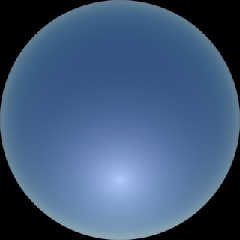
|
 |
|  |
|  |
|
 |
|
 |
|  |
|
 |




![]()